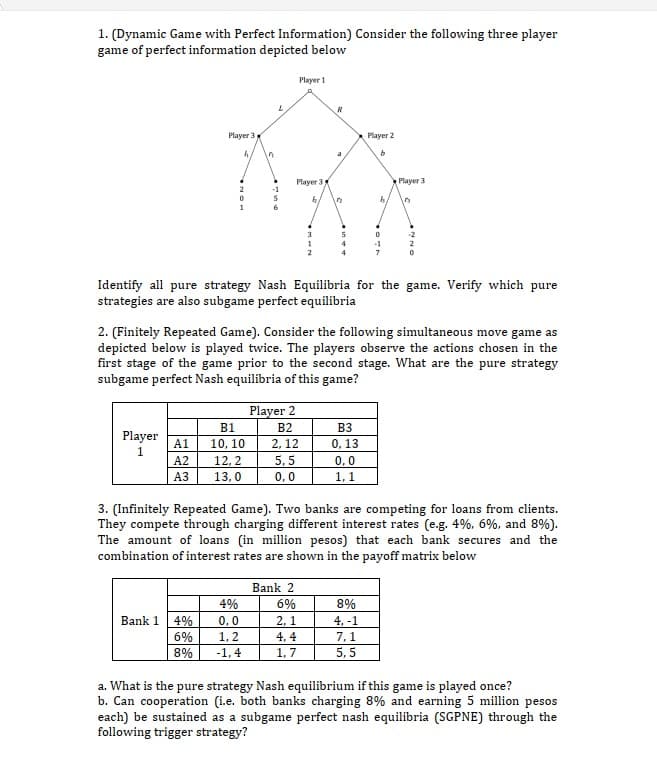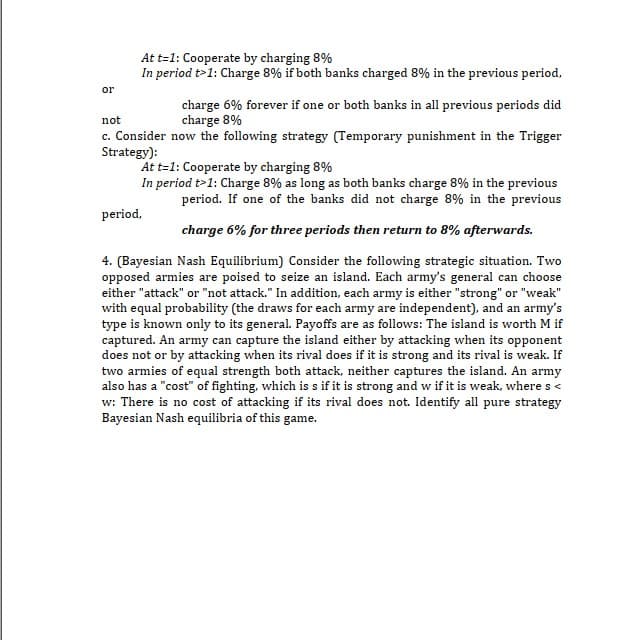1. (Dynamic Game with Perfect Information) Consider the following three player game of perfect information depicted below Player 1 Player 3 h " R Player 2 a b Player 3 Player 3 2 -1 0 S h 12 b. 1 3 5 0 4 Identify all pure strategy Nash Equilibria for the game. Verify which pure strategies are also subgame perfect equilibria 2. (Finitely Repeated Game). Consider the following simultaneous move game as depicted below is played twice. The players observe the actions chosen in the first stage of the game prior to the second stage. What are the pure strategy subgame perfect Nash equilibria of this game? Player 2 B1 B2 B3 Player 1 A1 10, 10 2,12 0,13 A2 12,2 5,5 0,0 A3 13,0 0,0 1,1 3. (Infinitely Repeated Game). Two banks are competing for loans from clients. They compete through charging different interest rates (e.g. 4%, 6%, and 8%). The amount of loans (in million pesos) that each bank secures and the combination of interest rates are shown in the payoff matrix below Bank 2 4% 6% 8% Bank 1 4% 0,0 2,1 4, -1 6% 1,2 4,4 7,1 8% -1,4 1,7 5,5 a. What is the pure strategy Nash equilibrium if this game is played once? b. Can cooperation (i.e. both banks charging 8% and earning 5 million pesos each) be sustained as a subgame perfect nash equilibria (SGPNE) through the following trigger strategy? or not At t=1: Cooperate by charging 8% In period t>1: Charge 8% if both banks charged 8% in the previous period, charge 6% forever if one or both banks in all previous periods did charge 8% c. Consider now the following strategy (Temporary punishment in the Trigger Strategy): period, At t=1: Cooperate by charging 8% In period t>1: Charge 8% as long as both banks charge 8% in the previous period. If one of the banks did not charge 8% in the previous charge 6% for three periods then return to 8% afterwards. 4. (Bayesian Nash Equilibrium) Consider the following strategic situation. Two opposed armies are poised to seize an island. Each army's general can choose either "attack" or "not attack." In addition, each army is either "strong" or "weak" with equal probability (the draws for each army are independent), and an army's type is known only to its general. Payoffs are as follows: The island is worth M if captured. An army can capture the island either by attacking when its opponent does not or by attacking when its rival does if it is strong and its rival is weak. If two armies of equal strength both attack, neither captures the island. An army also has a "cost" of fighting, which is s if it is strong and w if it is weak, where s < w: There is no cost of attacking if its rival does not. Identify all pure strategy Bayesian Nash equilibria of this game.
1. (Dynamic Game with Perfect Information) Consider the following three player game of perfect information depicted below Player 1 Player 3 h " R Player 2 a b Player 3 Player 3 2 -1 0 S h 12 b. 1 3 5 0 4 Identify all pure strategy Nash Equilibria for the game. Verify which pure strategies are also subgame perfect equilibria 2. (Finitely Repeated Game). Consider the following simultaneous move game as depicted below is played twice. The players observe the actions chosen in the first stage of the game prior to the second stage. What are the pure strategy subgame perfect Nash equilibria of this game? Player 2 B1 B2 B3 Player 1 A1 10, 10 2,12 0,13 A2 12,2 5,5 0,0 A3 13,0 0,0 1,1 3. (Infinitely Repeated Game). Two banks are competing for loans from clients. They compete through charging different interest rates (e.g. 4%, 6%, and 8%). The amount of loans (in million pesos) that each bank secures and the combination of interest rates are shown in the payoff matrix below Bank 2 4% 6% 8% Bank 1 4% 0,0 2,1 4, -1 6% 1,2 4,4 7,1 8% -1,4 1,7 5,5 a. What is the pure strategy Nash equilibrium if this game is played once? b. Can cooperation (i.e. both banks charging 8% and earning 5 million pesos each) be sustained as a subgame perfect nash equilibria (SGPNE) through the following trigger strategy? or not At t=1: Cooperate by charging 8% In period t>1: Charge 8% if both banks charged 8% in the previous period, charge 6% forever if one or both banks in all previous periods did charge 8% c. Consider now the following strategy (Temporary punishment in the Trigger Strategy): period, At t=1: Cooperate by charging 8% In period t>1: Charge 8% as long as both banks charge 8% in the previous period. If one of the banks did not charge 8% in the previous charge 6% for three periods then return to 8% afterwards. 4. (Bayesian Nash Equilibrium) Consider the following strategic situation. Two opposed armies are poised to seize an island. Each army's general can choose either "attack" or "not attack." In addition, each army is either "strong" or "weak" with equal probability (the draws for each army are independent), and an army's type is known only to its general. Payoffs are as follows: The island is worth M if captured. An army can capture the island either by attacking when its opponent does not or by attacking when its rival does if it is strong and its rival is weak. If two armies of equal strength both attack, neither captures the island. An army also has a "cost" of fighting, which is s if it is strong and w if it is weak, where s < w: There is no cost of attacking if its rival does not. Identify all pure strategy Bayesian Nash equilibria of this game.
Principles of Microeconomics
7th Edition
ISBN:9781305156050
Author:N. Gregory Mankiw
Publisher:N. Gregory Mankiw
Chapter17: Oligopoly
Section: Chapter Questions
Problem 5CQQ
Related questions
Question
100%
1. (Dynamic Game with Perfect Information)

Transcribed Image Text:1. (Dynamic Game with Perfect Information) Consider the following three player
game of perfect information depicted below
Player 1
Player 3
h
"
R
Player 2
a
b
Player 3
Player 3
2
-1
0
S
h
12
b.
1
3
5
0
4
Identify all pure strategy Nash Equilibria for the game. Verify which pure
strategies are also subgame perfect equilibria
2. (Finitely Repeated Game). Consider the following simultaneous move game as
depicted below is played twice. The players observe the actions chosen in the
first stage of the game prior to the second stage. What are the pure strategy
subgame perfect Nash equilibria of this game?
Player 2
B1
B2
B3
Player
1
A1
10, 10
2,12
0,13
A2
12,2
5,5
0,0
A3
13,0
0,0
1,1
3. (Infinitely Repeated Game). Two banks are competing for loans from clients.
They compete through charging different interest rates (e.g. 4%, 6%, and 8%).
The amount of loans (in million pesos) that each bank secures and the
combination of interest rates are shown in the payoff matrix below
Bank 2
4%
6%
8%
Bank 1
4% 0,0
2,1
4, -1
6%
1,2
4,4
7,1
8%
-1,4
1,7
5,5
a. What is the pure strategy Nash equilibrium if this game is played once?
b. Can cooperation (i.e. both banks charging 8% and earning 5 million pesos
each) be sustained as a subgame perfect nash equilibria (SGPNE) through the
following trigger strategy?

Transcribed Image Text:or
not
At t=1: Cooperate by charging 8%
In period t>1: Charge 8% if both banks charged 8% in the previous period,
charge 6% forever if one or both banks in all previous periods did
charge 8%
c. Consider now the following strategy (Temporary punishment in the Trigger
Strategy):
period,
At t=1: Cooperate by charging 8%
In period t>1: Charge 8% as long as both banks charge 8% in the previous
period. If one of the banks did not charge 8% in the previous
charge 6% for three periods then return to 8% afterwards.
4. (Bayesian Nash Equilibrium) Consider the following strategic situation. Two
opposed armies are poised to seize an island. Each army's general can choose
either "attack" or "not attack." In addition, each army is either "strong" or "weak"
with equal probability (the draws for each army are independent), and an army's
type is known only to its general. Payoffs are as follows: The island is worth M if
captured. An army can capture the island either by attacking when its opponent
does not or by attacking when its rival does if it is strong and its rival is weak. If
two armies of equal strength both attack, neither captures the island. An army
also has a "cost" of fighting, which is s if it is strong and w if it is weak, where s <
w: There is no cost of attacking if its rival does not. Identify all pure strategy
Bayesian Nash equilibria of this game.
Expert Solution
This question has been solved!
Explore an expertly crafted, step-by-step solution for a thorough understanding of key concepts.
Step by step
Solved in 2 steps with 1 images

Recommended textbooks for you

Principles of Microeconomics
Economics
ISBN:
9781305156050
Author:
N. Gregory Mankiw
Publisher:
Cengage Learning


Principles of Economics, 7th Edition (MindTap Cou…
Economics
ISBN:
9781285165875
Author:
N. Gregory Mankiw
Publisher:
Cengage Learning

Principles of Microeconomics
Economics
ISBN:
9781305156050
Author:
N. Gregory Mankiw
Publisher:
Cengage Learning


Principles of Economics, 7th Edition (MindTap Cou…
Economics
ISBN:
9781285165875
Author:
N. Gregory Mankiw
Publisher:
Cengage Learning

Principles of Economics (MindTap Course List)
Economics
ISBN:
9781305585126
Author:
N. Gregory Mankiw
Publisher:
Cengage Learning

Principles of Microeconomics (MindTap Course List)
Economics
ISBN:
9781305971493
Author:
N. Gregory Mankiw
Publisher:
Cengage Learning